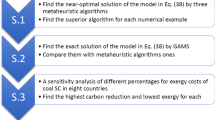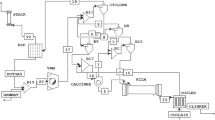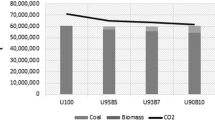Abstract
Coal-fired power plants are one of the most important targets with respect to reduction of CO2 emissions. The reasons for this are that coal-fired power plants offer localized large point sources (LPS) of CO2 and that the Indian power sector contributes to roughly half of all-India CO2 emissions. CO2 capture and storage (CCS) can be implemented in these power plants for long-term decarbonisation of the Indian economy. In this paper, two artificial intelligence (AI) techniques—adaptive network based fuzzy inference system (ANFIS) and multi gene genetic programming (MGGP) are used to model Indian coal-fired power plants with CO2 capture. The data set of 75 power plants take the plant size, the capture type, the load and the CO2 emission as the input and the COE and annual CO2 emissions as the output. It is found that MGGP is more suited to these applications with an R2 value of more than 99% between the predicted and actual values, as against the ~96% correlation for the ANFIS approach. MGGP also gives the traditionally expected results in sensitivity analysis, which ANFIS fails to give. Several other parameters in the base plant and CO2 capture unit may be included in similar studies to give a more accurate result. This is because MGGP gives a better perspective toward qualitative data, such as capture type, as compared to ANFIS.
Similar content being viewed by others
References
Sathaye J, Shukla P R. Methods and models for costing carbon mitigation. Annual Review of Environment and Resources, 2013, 38(1): 137–168
Sharma S K, Choudhury A, Sarkar P, Biswas S, Singh A, Dadhich P K, Singh A K, Majumdar S, Bhatia A, Mohini M, Kumar R. Greenhouse gas inventory estimates for India. Current Science, 2011, 101(3): 405–415
Goel M. Recent approaches in CO2 fixation research in India and future perspectives towards zero emission coal based power generation. Current Science, 2009, 97(11): 1625–1633
IPCC. Special Report on Carbon Dioxide Capture and Storage. Cambridge: Cambridge University Press, 2005, https://www.ipcc. ch/report/srccs/
Haszeldine R S. Carbon capture and storage: how green can black be? Science, 2009, 325(5948): 1647–1652
Singh U. Carbon capture and storage: an effective way to mitigate global warming. Current Science, 2013, 105(7): 914–922
Rubin E S, Davison J E, Herzog H J. The cost of CO2 capture and storage. International Journal of Greenhouse Gas Control, 2015, 40: 378–400
Shukla P, Dhar S, Pathak M, Mahadevia D, Garg A. Pathways to deep decarbonization in India. SDSN-IDDRI, 2015, http://deepdecarbonization. org/wp-content/uploads/2015/09/DDPP_IND.pdf
Rao A B, Rubin E S. A technical, economic, and environmental assessment of amine-based CO2 capture technology for power plant greenhouse gas control. Environmental Science & Technology, 2002, 36(20): 4467–4475
Rubin E S, Chen C, Rao A B. Cost and performance of fossil fuel power plants with CO2 capture and storage. Energy Policy, 2007, 35 (9): 4444–4454
Singh U, Rao A B. Estimating the environmental implications of implementing carbon capture and storage in Indian coal power plants. In: Proceedings on Advances in Green Energy (ICAGE). IEEE, 2014, 226–232
Singh R, Kainthola A, Singh T N. Estimation of elastic constant of rocks using an ANFIS approach. Applied Soft Computing, 2012, 12 (1): 40–45
Takagi T, Sugeno M. Fuzzy identification of systems and its applications to modeling and control. IEEE Transactions on Systems, Man, and Cybernetics, 1985, SMC-15 (1): 116–132
Sugeno M, Kang G T. Structure identification of fuzzy model. Fuzzy Sets and Systems, 1988, 28(1): 15–33
Jang J S. ANFIS: adaptive-network-based fuzzy inference system. IEEE Transactions on Systems, Man, and Cybernetics, 1993, 23(3): 665–685
Sahu M, Singh P, Mahapatra S S, Khatua K K. Prediction of entrance length for low Reynolds number flow in pipe using neurofuzzy inference system. Expert Systems with Applications, 2012, 39 (4): 4545–4557
Koza J R. Genetic Programming: on the Programming of Computers by Means of Natural Selection. Boston: MIT Press, 1992
Garg A, Vijayaraghavan V, Mahapatra S S, Tai K, Wong C H. Performance evaluation of microbial fuel cell by artificial intelligence methods. Expert Systems with Applications, 2014, 41 (4): 1389–1399
Garg A, Garg A, Tai K. A multi-gene genetic programming model for estimating stress-dependent soil water retention curves. Computational Geosciences, 2014, 18(1): 45–56
Searson D P. GPTIPS 2: An open-source software platform for symbolic data mining. In: Gandomi A.H., Alavi A.H. and Ryan, C. (eds.), Handbook of Genetic Programming Applications. Springer, Switzerland. 2015
CEA. CO2 baseline database for the Indian power sector, Central Electricity Authority, Ministry of Power, Government of India, New Delhi. 2016, http://www.cea.nic.in/reports/others/thermal/tpece/ cdm_CO2/user_guide_ver11.pdf
Berkenpas M B, Frey H C, Fry J J, Kalagnanam J, Rubin E S. Integrated environmental control model technical documentation. Center for Energy and Environmental Studies. Carnegie Mellon University, USA. 1999, https://www.cmu.edu/epp/iecm/IECM_Publications/ 1999ra%20Berkenpas%20et%20al,%20IECM%20Tech. pdf
Singh U, Rao A B. Integrating SO2 and NOx control systems in Indian coal-fired power plants. Decision, 2015, 42(2): 191–209
Rao A B, Rubin E S. Identifying cost-effective CO2 control levels for amine-based CO2 capture systems. Industrial & Engineering Chemistry Research, 2006, 45(8): 2421–2429
Tan R R, Ng D K, Foo D C, Aviso K B. Crisp and fuzzy integer programming models for optimal carbon sequestration retrofit in the power sector. Chemical Engineering Research & Design, 2010, 88 (12): 1580–1588
Author information
Authors and Affiliations
Corresponding author
Rights and permissions
About this article
Cite this article
Sharma, N., Singh, U. & Mahapatra, S.S. Prediction of cost and emission from Indian coal-fired power plants with CO2 capture and storage using artificial intelligence techniques. Front. Energy 13, 149–162 (2019). https://doi.org/10.1007/s11708-017-0482-6
Received:
Accepted:
Published:
Issue Date:
DOI: https://doi.org/10.1007/s11708-017-0482-6




